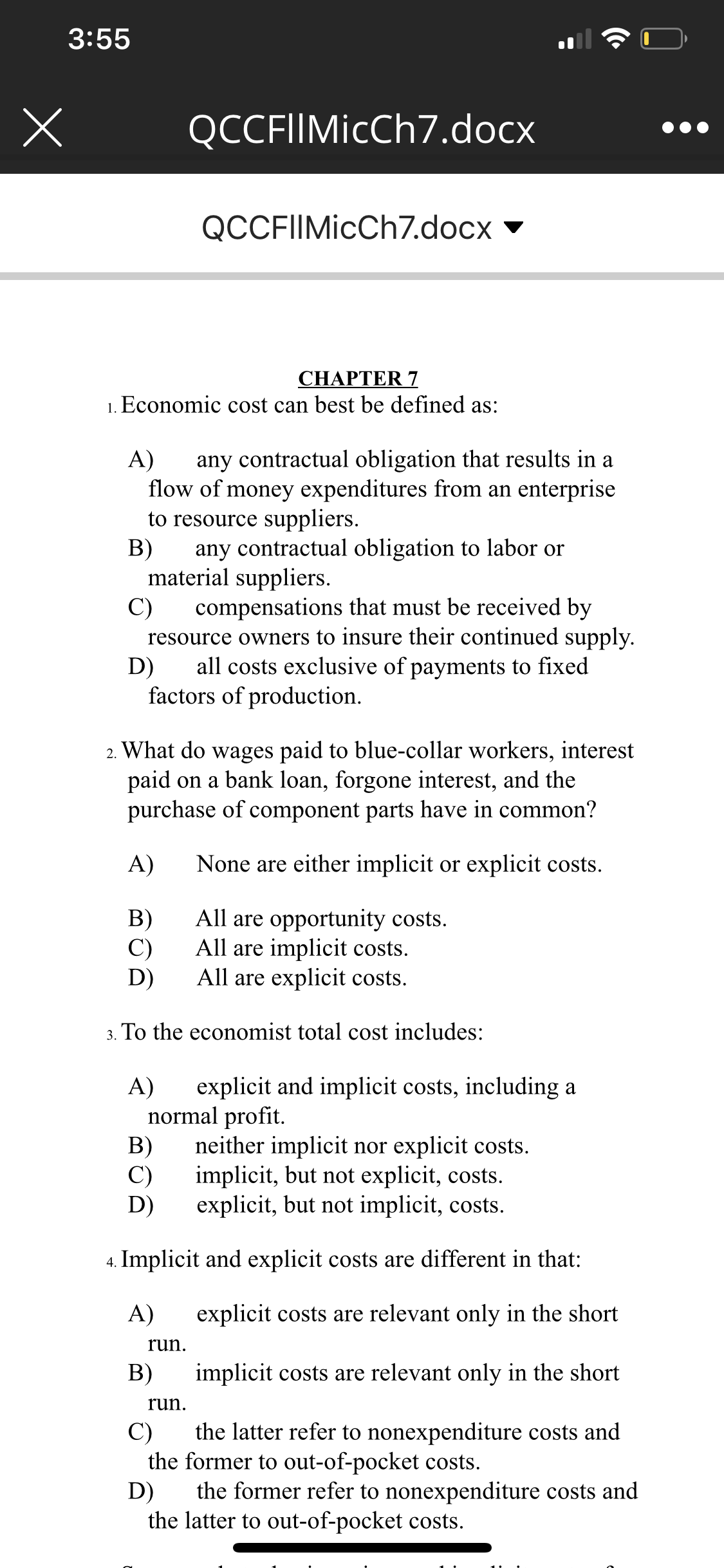3:55 QCCFIIMicCh7.docx QCCFIIMicCh7.docx CHAPTER 7 1. Economic cost can best be defined as: any contractual obligation that results in a flow of money expenditures from an enterprise to resource suppliers. B) A) any contractual obligation to labor or material suppliers. C) compensations that must be received by resource owners to insure their continued supply. all costs exclusive of payments to fixed D) factors of production. 2. What do wages paid to blue-collar workers, interest paid on a bank loan, forgone interest, and the purchase of component parts have in common? A) None are either implicit or explicit costs. B) C) D) All are opportunity costs. All are implicit costs. All are explicit costs. 3. To the economist total cost includes: A) explicit and implicit costs, including a normal profit. neither implicit nor explicit costs. B) C) implicit, but not explicit, costs. D) explicit, but not implicit, costs. 4. Implicit and explicit costs are different in that: A) explicit costs are relevant only in the short run. B) implicit costs are relevant only in the short run. C) the latter refer to nonexpenditure costs and the former to out-of-pocket costs. D) the former refer to nonexpenditure costs and the latter to out-of-pocket costs.
3:55 QCCFIIMicCh7.docx QCCFIIMicCh7.docx CHAPTER 7 1. Economic cost can best be defined as: any contractual obligation that results in a flow of money expenditures from an enterprise to resource suppliers. B) A) any contractual obligation to labor or material suppliers. C) compensations that must be received by resource owners to insure their continued supply. all costs exclusive of payments to fixed D) factors of production. 2. What do wages paid to blue-collar workers, interest paid on a bank loan, forgone interest, and the purchase of component parts have in common? A) None are either implicit or explicit costs. B) C) D) All are opportunity costs. All are implicit costs. All are explicit costs. 3. To the economist total cost includes: A) explicit and implicit costs, including a normal profit. neither implicit nor explicit costs. B) C) implicit, but not explicit, costs. D) explicit, but not implicit, costs. 4. Implicit and explicit costs are different in that: A) explicit costs are relevant only in the short run. B) implicit costs are relevant only in the short run. C) the latter refer to nonexpenditure costs and the former to out-of-pocket costs. D) the former refer to nonexpenditure costs and the latter to out-of-pocket costs.
Chapter11: The Firm: Production And Costs
Section: Chapter Questions
Problem 15P
Related questions
Question

Transcribed Image Text:3:55
QCCFIIMicCh7.docx
QCCFIIMicCh7.docx
CHAPTER 7
1. Economic cost can best be defined as:
any contractual obligation that results in a
flow of money expenditures from an enterprise
to resource suppliers.
B)
A)
any contractual obligation to labor or
material suppliers.
C)
compensations that must be received by
resource owners to insure their continued supply.
all costs exclusive of payments to fixed
D)
factors of production.
2. What do wages paid to blue-collar workers, interest
paid on a bank loan, forgone interest, and the
purchase of component parts have in common?
A)
None are either implicit or explicit costs.
B)
C)
D)
All are opportunity costs.
All are implicit costs.
All are explicit costs.
3. To the economist total cost includes:
A)
explicit and implicit costs, including a
normal profit.
neither implicit nor explicit costs.
B)
C)
implicit, but not explicit, costs.
D)
explicit, but not implicit, costs.
4. Implicit and explicit costs are different in that:
A)
explicit costs are relevant only in the short
run.
B)
implicit costs are relevant only in the short
run.
C)
the latter refer to nonexpenditure costs and
the former to out-of-pocket costs.
D)
the former refer to nonexpenditure costs and
the latter to out-of-pocket costs.
Expert Solution
This question has been solved!
Explore an expertly crafted, step-by-step solution for a thorough understanding of key concepts.
This is a popular solution!
Trending now
This is a popular solution!
Step by step
Solved in 2 steps

Recommended textbooks for you

Exploring Economics
Economics
ISBN:
9781544336329
Author:
Robert L. Sexton
Publisher:
SAGE Publications, Inc


Managerial Economics: A Problem Solving Approach
Economics
ISBN:
9781337106665
Author:
Luke M. Froeb, Brian T. McCann, Michael R. Ward, Mike Shor
Publisher:
Cengage Learning

Exploring Economics
Economics
ISBN:
9781544336329
Author:
Robert L. Sexton
Publisher:
SAGE Publications, Inc


Managerial Economics: A Problem Solving Approach
Economics
ISBN:
9781337106665
Author:
Luke M. Froeb, Brian T. McCann, Michael R. Ward, Mike Shor
Publisher:
Cengage Learning


